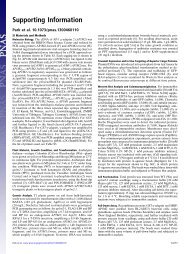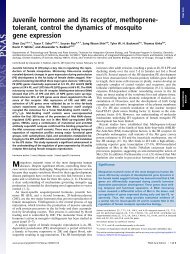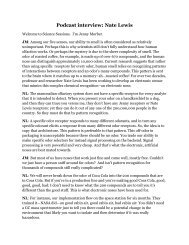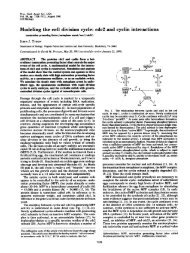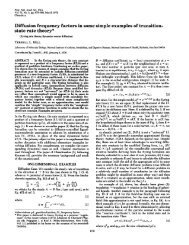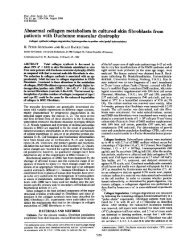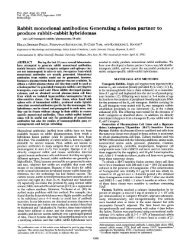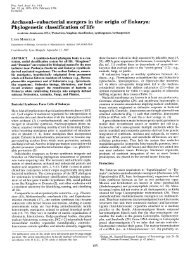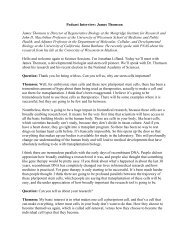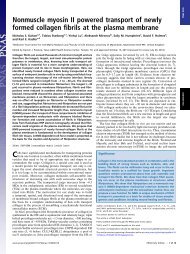Superiority illusion arises from resting-state brain networks ...
Superiority illusion arises from resting-state brain networks ...
Superiority illusion arises from resting-state brain networks ...
You also want an ePaper? Increase the reach of your titles
YUMPU automatically turns print PDFs into web optimized ePapers that Google loves.
<strong>Superiority</strong> <strong>illusion</strong> <strong>arises</strong> <strong>from</strong> <strong>resting</strong>-<strong>state</strong> <strong>brain</strong><br />
<strong>networks</strong> modulated by dopamine<br />
Makiko Yamada a,b,1 , Lucina Q. Uddin c , Hidehiko Takahashi a , Yasuyuki Kimura a , Keisuke Takahata a , Ririko Kousa a ,<br />
Yoko Ikoma a , Yoko Eguchi a , Harumasa Takano a , Hiroshi Ito a , Makoto Higuchi a , and Tetsuya Suhara a<br />
a Molecular Neuroimaging Program, Molecular Imaging Center, National Institute of Radiological Sciences, Chiba 263-8555, Japan; b Decoding and Controlling<br />
Brain Information, Precursory Research for Embryonic Science and Technology, Japan Science and Technology Agency, Saitama 332-0012, Japan; and<br />
c Department of Psychiatry and Behavioral Sciences, Stanford University School of Medicine, Palo Alto, CA 94304<br />
Edited by Marcus E. Raichle, Washington University in St. Louis, St. Louis, MO, and approved January 8, 2013 (received for review December 12, 2012)<br />
The majority of individuals evaluate themselves as superior to<br />
average. This is a cognitive bias known as the “superiority <strong>illusion</strong>.” This<br />
<strong>illusion</strong> helps us to have hope for the future and is deep-rooted in the<br />
process of human evolution. In this study, we examined the default<br />
<strong>state</strong>s of neural and molecular systems that generate this <strong>illusion</strong>, using<br />
<strong>resting</strong>-<strong>state</strong> functional MRI and PET. Resting-<strong>state</strong> functional connectivity<br />
between the frontal cortex and striatum regulated by inhibitory<br />
dopaminergic neurotransmission determines individual levels of the<br />
superiority <strong>illusion</strong>. Our findings help elucidate how this key aspect<br />
of the human mind is biologically determined, and identify potential<br />
molecular and neural targets for treatment for depressive realism.<br />
positive <strong>illusion</strong> | dorsal anterior cingulate cortex | sensorimotor striatum |<br />
behavioral control | hopelessness<br />
As so eloquently <strong>state</strong>d by Lionel Tiger (1), “optimism has<br />
been central to the process of human evolution” and is<br />
important to the welfare of communities, a subjective but discrete<br />
process that should be biologically determined. A positive<br />
outlook concerning one’s own ability, personality, and future is<br />
an essential aspect of the human mind. It motivates future goals<br />
and helps us prepare for upcoming challenges. Positively evaluating<br />
the self, a concept termed the “superiority <strong>illusion</strong>,” involves<br />
judging oneself as being superior to average people along various<br />
dimensions, such as intelligence, cognitive ability, and possession<br />
of desirable traits. This concept contains a well-recognized mathematical<br />
flaw, however. Most people are not more desirable than<br />
average and do not possess most of the desirable characteristics,<br />
assuming a normal distribution of the population (2). The superiority<br />
<strong>illusion</strong> is one type of positive <strong>illusion</strong>; other types include<br />
optimism bias and <strong>illusion</strong> of control (3). Whereas the superiority<br />
<strong>illusion</strong> is specifically about one’s own abilities/characteristics,<br />
optimism bias involves one’s own future, and <strong>illusion</strong> of control<br />
involves personal control over environmental circumstances; all<br />
are considered common aspects of unrealistic favorable attitudes<br />
toward oneself and promotion for mental health (3). These positive<br />
beliefs of the human mind have attracted the attention of a<br />
wide range of investigators, including anthropologists, biologists,<br />
psychologists, clinicians, and neuroscientists.<br />
Moderately positive <strong>illusion</strong>s are important for mental health<br />
(3); negative thoughts about the self are characteristic of depression<br />
(4). One study reported that the severity of depressive<br />
symptoms is negatively correlated with optimism bias, as measured<br />
by self-estimation of one’s own possible future events (5).<br />
A recent computational model further suggested that positive<br />
<strong>illusion</strong>s are evolutionarily selected (6). Given that the superiority<br />
<strong>illusion</strong> is a phylogenetically old aspect of human cognition,<br />
it can be assumed that the <strong>brain</strong> has evolved to support it.<br />
A growing number of neuroimaging studies using functional<br />
MRI (fMRI) have identified the neural substrates of the self, including<br />
self-evaluation. It is reported that relating oneself to<br />
positive traits, but not negative traits, is associated with activation<br />
of the medial prefrontal cortex (MPFC), both dorsal (DMPFC)<br />
and ventral (VMPFC), as well as the supplemental motor area,<br />
and anterior cingulate cortex (ACC), both dorsal (dACC) and<br />
ventral (7). Moreover, activation of the dACC and orbitofrontal<br />
cortex (OFC) during social-comparative judgments of self-traits is<br />
negatively associated with the degree of the superiority <strong>illusion</strong><br />
(or “above-average effect”) (8). The dACC and OFC have a “topdown”<br />
inhibitory controlling effect on other <strong>brain</strong> regions (9), and<br />
thus also contribute to the suppression of heuristic approaches to<br />
positive self-evaluation (8). Inte<strong>resting</strong>ly, depressive patients reportedly<br />
exhibit increased ACC activation when attributing negative<br />
emotions to themselves (10).<br />
The MPFC, along with the striatum, compose loops known as<br />
fronto-striatal circuits (11). A meta-analysis of 126 task-based<br />
neuroimaging studies reported coactivation between the striatum<br />
and the MPFC, including the ACC (12). In addition, recent<br />
advances in functional connectivity (FC) analyses of <strong>resting</strong>-<strong>state</strong><br />
fMRI data (13) have provided insight into the <strong>brain</strong>’s intrinsic<br />
functional architecture in healthy individuals, as well as psychiatric<br />
patients. FC between the striatum and MPFC was observed in<br />
the healthy <strong>resting</strong> <strong>brain</strong> (14), whereas patients with depression<br />
showed <strong>resting</strong>-<strong>state</strong> hyperconnectivity in the ACC, VMPFC,<br />
putamen/pallidum, and substantia nigra/ventral tegmental area<br />
(15), the latter an origin of dopaminergic projections, implicating<br />
dopaminergic neural circuits in cognitive and affective functions.<br />
A notable neurochemical feature of the striatum is its high<br />
density of dopamine D 2 receptors, as the major receiving site<br />
of dopaminergic projections <strong>from</strong> the substantia nigra/ventral<br />
tegmental area. Individual differences in striatal D 2 receptor<br />
availability have been associated with personality, mood, and<br />
psychiatric symptoms. Healthy subjects with lower D 2 receptor<br />
availability, presumably due to higher presynaptic dopamine release<br />
(16), in the dorsal, but not ventral, striatum had a propensity<br />
to rate themselves as highly socially desirable (17). Self-reported<br />
social desirability is negatively associated with subjective hopelessness<br />
(18), as measured by the Beck Hopelessness Scale (BHS)<br />
(19), an index of feelings about the future, expectations, and loss<br />
of motivation. In line with these observations, there is evidence<br />
that levodopa increases positive expectations for one’s future<br />
(20). In addition, increased striatal D 2 receptor availability in<br />
patients with depression is related to enhanced inhibition of<br />
motor and thought processes (21), whereas patients with addiction<br />
show low D 2 receptor availability in the striatum, associated with<br />
impaired inhibitory control of impulsivity (22), indicating the<br />
critical involvement of D 2 receptors in inhibitory processes (23).<br />
Author contributions: M.Y. designed research; M.Y., K.T., R.K., Y.E., and H. Takano performed<br />
research; M.Y. and L.Q.U. contributed new reagents/analytic tools; M.Y., L.Q.U.,<br />
Y.K., R.K., and Y.I. analyzed data; and M.Y., L.Q.U., H. Takahashi, H. Takano, H.I., M.H.,<br />
and T.S. wrote the paper.<br />
The authors declare no conflict of interest.<br />
This article is a PNAS Direct Submission.<br />
Freely available online through the PNAS open access option.<br />
1 To whom correspondence should be addressed. E-mail: myamada@nirs.go.jp.<br />
This article contains supporting information online at www.pnas.org/lookup/suppl/doi:10.<br />
1073/pnas.1221681110/-/DCSupplemental.<br />
NEUROSCIENCE<br />
PSYCHOLOGICAL AND<br />
COGNITIVE SCIENCES<br />
www.pnas.org/cgi/doi/10.1073/pnas.1221681110 PNAS Early Edition | 1of5
Dopamine neurotransmission has an effect on frontal and<br />
striatal activations as well. The administration of D 2 agonists<br />
suppresses activity in the prefrontal cortex during cognitive processing<br />
(24), and the D 2 receptor genotype modulates FC strength<br />
within the default mode network and the striatum (25). Taken<br />
together, these findings suggest a possible impact of striatal dopaminergic<br />
<strong>state</strong>s on <strong>resting</strong>-<strong>state</strong> fronto-striatal connectivity.<br />
Based on the aforementioned findings <strong>from</strong> isolated PET<br />
and fMRI studies, we may speculate about the possible interrelationship<br />
among MPFC-striatal connectivity, striatal D 2 receptor<br />
availability, and the superiority <strong>illusion</strong>. There is currently<br />
no direct conclusive evidence on this issue, however. In the present<br />
study, we aimed to clarify these interrelations, using <strong>resting</strong><strong>state</strong><br />
fMRI and PET measurements, which examine the intrinsic<br />
functional and chemical <strong>state</strong>s of the <strong>brain</strong>, respectively. This<br />
approach makes possible the elucidation of the neural mechanisms<br />
underlying the superiority <strong>illusion</strong> by uncovering the potential<br />
role of striatal D 2 receptors in modulating interactions between<br />
the striatum and frontal cortex.<br />
Results<br />
We first examined the relationship between scores on the superiority<br />
<strong>illusion</strong> task and BHS, which has been related positively<br />
to depression symptom severity (18). The majority of subjects<br />
exhibited low to mild hopelessness (median, 4.0; range, 2.0–6.0)<br />
(Fig. 1A) and a moderate level of the superiority <strong>illusion</strong> (median,<br />
0.22; range, 0.16–0.335) (Fig. 1B). Correlation analysis<br />
revealed a negative relationship between these two measures<br />
(n = 24; r = −0.60, P = 0.002, Spearman’s rank test) (Fig. 1C). To<br />
further characterize the study subjects, we also measured trait<br />
anxiety and self-esteem using the State-Trait Anxiety Inventory<br />
(26) and Rosenberg Self-Esteem Scale (27), respectively. Neither<br />
of these measures was correlated with the superiority <strong>illusion</strong> (all<br />
P > 0.05) (Table S1). These findings suggest that the superiority<br />
<strong>illusion</strong> measures belief, independent of anxiety or self-esteem.<br />
We then looked for <strong>resting</strong>-<strong>state</strong> FC in relation to D 2 receptor<br />
availability in the dorsal striatum. For this analysis, we divided<br />
the dorsal striatum into two functional subdivisions: associative<br />
striatum (AST) and sensorimotor striatum (SMST) (Materials<br />
and Methods). In these regions, nondisplaceable binding potentials<br />
(BP ND ) of a PET imaging agent for D 2 receptor, [ 11 C]<br />
raclopride, which represent D 2 receptor availability (Table S2),<br />
were regressed with the <strong>resting</strong>-<strong>state</strong> FC for each seed (AST and<br />
SMST, bilaterally). Our values for striatal FC (z > 2.3; cluster<br />
significance, P < 0.05 corrected; Fig. S1) are in accordance with<br />
previous reports (14). The <strong>resting</strong>-<strong>state</strong> striatal FC, which was<br />
correlated with D 2 BP ND in each region of interest (ROI) by<br />
application of a frontal lobe mask, is provided in Fig. S2 and<br />
Table S3 (z > 2.3; cluster significance, P < 0.05 corrected).<br />
Finally, we searched the regions correlated with the superiority<br />
<strong>illusion</strong> restricted to D 2 BP ND -correlated striatal FCs in<br />
Table S3 with Bonferroni correction separately for each ROI,<br />
and then applied path modeling (mediation analysis) to test<br />
whether striatal D 2 receptor availability leads to the superiority<br />
<strong>illusion</strong> by modulating striatal FC. We found that the superiority<br />
<strong>illusion</strong> was negatively correlated with FC between the dACC<br />
and left SMST (n = 24; r = −0.57, P = 0.0035, Spearman’s rank<br />
test) (Fig. 2), but not with FCs involving right SMST or the AST.<br />
We also tested whether the dACC-striatal FC overlapped with<br />
the results obtained when superiority <strong>illusion</strong> scores were<br />
regressed with the <strong>resting</strong>-<strong>state</strong> FC for left SMST. We confirmed<br />
that the dACC-striatal FC-correlated D 2 BP ND overlapped with<br />
the FC-correlated superiority <strong>illusion</strong> (z > 2.3; cluster significance,<br />
P < 0.05 corrected) (Fig. S3C). There was no significant<br />
correlation between D 2 BP ND in left SMST and the superiority<br />
<strong>illusion</strong> (r = −0.1, P = 0.64).<br />
Mediation analysis based on 5,000 bootstrapped samples using<br />
bias-corrected and accelerated 95% confidence intervals (28)<br />
showed a significant indirect effect of striatal D 2 BP ND on the<br />
superiority <strong>illusion</strong> through dACC-striatal FC [indirect effect<br />
(IE) = −0.18; SE = 0.12; lower limit (LL) = −0.56; upper limit<br />
(UL) = −0.045] (Fig. 3). Because of concerns about two outliers<br />
with negative superiority <strong>illusion</strong> scores (Fig. 1B), we applied<br />
path modeling only for those with positive superiority <strong>illusion</strong><br />
scores (n = 22). This mediation analysis again confirmed the<br />
indirect effect through dACC-striatal FC (IE = −0.10, SE = 0.07;<br />
LL = −0.31; UL = −0.02).<br />
Discussion<br />
According to fMRI studies, the SMST plays an important role in<br />
motor and cognitive planning, such as action selection in resolving<br />
stimulus–response conflict (29). PET studies have reported a close<br />
association of D 2 receptor availability in the SMST with harm<br />
avoidance (30) and self-reported social desirability (17), suggesting<br />
that this region subserves these personality-related aspects of<br />
thought and behavior. Given that the dorsolateral striatum and its<br />
dopaminergic afferents support habitual or reflexive control (31),<br />
the contribution of the SMST to the superior <strong>illusion</strong> observed<br />
in the present study may reflect the habitual control of self-evaluation.<br />
Because the dACC is also the controlling site associated<br />
with more thoughtful or cognitive control (32), this region may<br />
act to control cognitively the propensity to evaluate oneself positively<br />
(8, 33). These two controllers in the <strong>brain</strong> are known to be<br />
interconnected (34), and our present findings suggest that they<br />
work together to control action selection for positive self-evaluation,<br />
which is under dopaminergic modulation.<br />
Dopaminergic modulation of neuronal communication is<br />
crucial to normal functioning of <strong>brain</strong> circuits contributing to<br />
Fig. 1. Behavioral results. (A) BHS scores (median, 4.0; range, 2.0–6.0). (B) <strong>Superiority</strong> <strong>illusion</strong> (median, 0.22; range, 0.16–0.335). (C) Relationship between BHS<br />
and superiority <strong>illusion</strong> (r = −0.60, P = 0.002).<br />
2of5 | www.pnas.org/cgi/doi/10.1073/pnas.1221681110 Yamada et al.
Fig. 2. Relationship between striatal FC and superiority <strong>illusion</strong>. A significant<br />
negative relationship between left SMST FC with dACC and superiority<br />
<strong>illusion</strong> can be seen (r = −0.57, P = 0.0035).<br />
thought and behavior (35). Stimulation of striatal D 2 receptors<br />
by dopamine likely suppresses inhibitory control by the frontostriatal<br />
circuits over impulsive responding (23). Assuming an inverse<br />
correlation between D 2 receptor availability and presynaptic<br />
dopamine release (16), this would be in agreement with our<br />
finding on the positive association of striatal D 2 receptor availability<br />
with the fronto-striatal FC. Keep in mind that D 2 receptor<br />
availability is also influenced by receptor density. The availability<br />
of striatal D 2 receptors reportedly parallels frontal metabolic<br />
activity, a marker of <strong>brain</strong> function. Specifically, reductions in<br />
striatal D 2 receptors in drug-addicted subjects who failed to<br />
demonstrate inhibitory control of impulsivity were associated<br />
with decreased metabolic activity in the OFC, ACC, and DLPFC<br />
(22). In this respect, our present results suggest that dopamine acts<br />
on striatal D 2 receptors to attenuate (i.e., suppress) FC between<br />
the ACC and striatum, leading to reduced control over the superiority<br />
<strong>illusion</strong> (Fig. 3).<br />
Although here dopamine is hypothesized to support the superiority<br />
<strong>illusion</strong> mediated through dACC-striatal FC, other<br />
molecular systems modulate FCs between striatum and prefrontal<br />
areas, including serotonin. Indeed, a recent pharamacologic<br />
study found that the antidepressant efficacy of SSRIs<br />
modulated the FC between ventral striatum and anteroventral<br />
prefrontal cortex, which is associated with the reward system<br />
(36). Networks related to depressive behavior may coexist in<br />
different loops between striatum and prefrontal areas, and thus<br />
the superiority <strong>illusion</strong> in particular might be best viewed as the<br />
products of larger-scale interactions of different loops and<br />
different molecular systems. These intertwined relationships remain<br />
to be resolved.<br />
In conclusion, the present study provides the neuromolecular<br />
basis for the superiority <strong>illusion</strong> by demonstrating an interrelationship<br />
between dopamine neurotransmission and frontostriatal<br />
FC. Given that the superiority <strong>illusion</strong> is negatively related<br />
to self-reported hopelessness (Fig. 1C), possession of this <strong>illusion</strong><br />
is important to mental health, promoting positive hope for the<br />
future. Understanding the neural and molecular mechanisms<br />
behind the superiority <strong>illusion</strong> is critical for understanding<br />
the nature of the human mind and the pathophysiology of psychiatric<br />
disorders. The present experimental paradigm will also be<br />
applicable to patients with depression, for examining how depressive<br />
realism is related to the proposed neuromolecular<br />
mechanisms, as well as to pharmacologic intervention targeting<br />
dopaminergic modulation of the superiority <strong>illusion</strong> via frontostriatal<br />
FC.<br />
Materials and Methods<br />
Subjects. Twenty-four right-handed healthy male subjects (mean age, 23.5 ±<br />
4.4 years) participated in the study. All subjects had normal or corrected<br />
vision, had no history of neurologic or psychiatric disorders, and were not<br />
taking any medications that could interfere with task performance or with<br />
PET data. The study was approved by the Ethics and Radiation Safety<br />
Committee of the National Institute of Radiological Sciences.<br />
Procedures. Each subject underwent both <strong>resting</strong>-<strong>state</strong> fMRI and PET scanning.<br />
Outside the scanner, each subject completed the superiority <strong>illusion</strong> task<br />
on a personal computer, as well as the BHS (19), State-Trait Anxiety Inventory<br />
(26), and Rosenberg Self-Esteem Scale (27).<br />
Behavioral Procedures. Stimuli and Task. Sixty personality words obtained <strong>from</strong><br />
Rosenberg et al. (37) were translated into Japanese. Pilot subjects (n = 14)<br />
rated social desirability for each word using a seven-point scale of −3 (very<br />
bad) to +3 (very good). The one-sample t test was applied to each word to<br />
test the significance of social desirability (better or worse). Based on statistical<br />
analyses, 52 significant words (all P < 0.005) were divided into good or<br />
bad personality traits (26 words for each category) for use in the experiment<br />
(Table S4). In the experiment outside the scanner, subjects were asked to<br />
rate how they compared themselves with the average peer on these personality<br />
traits using a visual analog scale (with scores raging <strong>from</strong> 0, below<br />
average, to 100, above average, with 50 = average). Each trial began with<br />
a fixation cross on a screen, followed by a trait word.<br />
Analysis. To obtain the magnitude of the superiority <strong>illusion</strong> (mean deviation<br />
<strong>from</strong> average) for each subject, ratings for negative traits were reverse-scored<br />
to collapse with ratings of positive traits. The mean deviation<br />
NEUROSCIENCE<br />
PSYCHOLOGICAL AND<br />
COGNITIVE SCIENCES<br />
Fig. 3. Influence of striatal D 2 availability on superiority <strong>illusion</strong> is mediated through dACC- striatal FC. Assuming an inverse relationship between D 2 receptor<br />
availability and presynaptic dopamine release (1), dopamine likely acts on striatal D 2 receptors to suppress FC between the dorsal striatum and dACC (2). This<br />
connectivity predicts individual differences in the superiority <strong>illusion</strong> (3). The indirect effect of striatal D 2 receptor availability on the superiority <strong>illusion</strong><br />
is significantly mediated through dACC-striatal FC (IE = − 0.18; SE = 0.12; LL = −0.56; UL = −0.045). “+” indicates a positive relationship; “–,” a negative<br />
relationship.<br />
Yamada et al. PNAS Early Edition | 3of5
was obtained as a ratio for each subject and was used for correlation analyses<br />
with questionnaires and FC data, using Spearman’s rank tests in SPSS.<br />
PET Procedures. Data Acquisition. All PET studies were performed with a Shimadzu<br />
SET-3000GCT/X machine (38), which provides 99 sections with an axial<br />
field of view of 26 cm. The intrinsic spatial resolution was 3.4 mm in plane<br />
and 5.0 mm FWHM axially. With a Gaussian filter (cutoff frequency, 0.3 cycle/<br />
pixel), the reconstructed in-plane resolution was 7.5 mm FWHM. Data were<br />
acquired in 3D mode. Scatter correction was provided using a hybrid scatter<br />
correction method based on acquisition with a dual-energy window setting<br />
(39). A 4-min transmission scan using a 137Cs line source was performed for<br />
correction of attenuation. For evaluation of striatal D 2 receptors, a bolus of<br />
223.4 ± 12.7 MBq of [ 11 C]raclopride with high specific radioactivity (195.8 ±<br />
72.8 GBq/umol) was injected i.v. <strong>from</strong> the antecubital vein with a 20-mL<br />
saline flush. Dynamic scans were performed for 60 min for [ 11 C]raclopride<br />
and for 60 min immediately after the injection.<br />
ROIs. Four ROIs were selected based on the anatomic and functional<br />
subdivisions of the striatum outlined by Mawlawi et al. (40). Each ROI was<br />
traced manually on MNI152 space in the left and right AST (precommisural<br />
dorsal cudate, precommisural dorsal putamen, and postcommisural caudate),<br />
and left and right SMST (postcommisural putamen).<br />
Data Analysis. Quantitative analysis was performed using the three-parameter<br />
simplified reference tissue model (41). The cerebellum was used as<br />
a reference region because it has been shown to be almost devoid of D 2<br />
receptors (42). The model provides an estimation of BP ND (43), which is defined<br />
by the following equation: BP ND = k3/k4 = f2 B max /{K d [1+Σi Fi/Kdi]},<br />
where k3 and k4 describe the bidirectional exchange of tracer between the<br />
free compartment and the compartment representing specific binding, f2 is<br />
the “free fraction” of nonspecifically bound radioligand in <strong>brain</strong>, B max is the<br />
receptor density, K d is the equilibrium dissociation constant for the radioligand,<br />
and Fi and Kdi are the free concentration and dissociation constant<br />
of competing ligands, respectively (41). Tissue concentrations of the radioactivities<br />
of [ 11 C]raclopride were obtained <strong>from</strong> ROIs defined on PET images<br />
of summated activity for 60 min, with reference to the individual MRIs<br />
coregistered on summated PET images and the <strong>brain</strong> atlas.<br />
fMRI Procedures. Data Acquisition. Resting-<strong>state</strong> functional imaging was performed<br />
with a GE 3.0-T Excite system to acquire gradient echo T2*-weighted<br />
echoplanar images with blood oxygenation level-dependent contrast. Each<br />
volume comprised 35 transaxial contiguous slices with a slice thickness of 3.8<br />
mm to cover almost the whole <strong>brain</strong> (flip angle, 75°; echo time, 25 ms;<br />
repetition time, 2,000 ms; matrix, 64 × 64; field of view, 24 × 24 cm; duration,<br />
6 min, 56 s). During scanning, subjects were instructed to rest with their eyes<br />
open. A high-resolution T1-weighted magnetization-prepared gradient<br />
echo sequence (124 contiguous axial slices; 3D spoiled-GRASS sequence; slice<br />
thickness, 1.5 mm; flip angle, 30°; echo time, 9 ms; repetition time, 22 ms;<br />
matrix, 256 × 192; field of view, 25 × 25 cm) was also collected for spatial<br />
normalization and localization.<br />
Preprocessing. Data processing was performed using scripts provided by the<br />
1,000 Functional Connectomes Project (www.nitrc.org/projects/fcon_1000).<br />
Preprocessing comprised slice time correction, 3D motion correction, temporal<br />
despiking, spatial smoothing (FWHM = 6 mm), mean-based intensity<br />
normalization, temporal bandpass filtering (0.009–0.1 Hz), linear and quadratic<br />
detrending, and nuisance signal removal (white matter, cerebrospinal<br />
fluid, global signal, motion parameters) via multiple regression. Registration<br />
of each subject’s high-resolution anatomic image to a common stereotaxic<br />
space (Montreal Neurological Institute 152-<strong>brain</strong> template, MNI152; 3 × 3 ×<br />
3mm 3 spatial resolution) was accomplished by two-step process, estimation<br />
of a 12-df linear affine transformation, followed by refinement of the registration<br />
using nonlinear registration, which was then applied to each subject’s<br />
functional dataset (44).<br />
ROI and Seed Selection. The four ROIs (left and right AST and left and right<br />
SMST) served as seeds for <strong>resting</strong>-<strong>state</strong> FC analyses. They were applied to<br />
each subject’s prewhitened 4D residuals, and a mean time series was calculated<br />
for each seed by averaging across all voxels within the seed.<br />
Seed-Based FC Analyses. Each subject’s 4D residual volume was spatially<br />
normalized by applying the previously computed transformation to MNI152<br />
3-mm standard space. Then the mean time series for each seed was determined<br />
by averaging across all voxels in each seed ROI. Using these mean<br />
time series, a correlation analysis for each subject and each ROI was performed<br />
using the AFNI program 3dfim+, carried out in each individual’s<br />
native space. This analysis produced subject-level correlation maps of all<br />
voxels in the <strong>brain</strong> that were positively correlated with the seed time series.<br />
Finally, these correlation maps were converted to z-value maps using Fisher<br />
r-to-z transformation onto MNI152 3-mm standard space.<br />
Group-Level Analyses. Group-level analyses for each seed ROI were carried<br />
out using a mixed-effects model (FLAME) implemented in FSL flameo. In<br />
addition to the group mean vector, the model included demeaned BP ND<br />
values and ages. Cluster-based statistical correction for multiple comparisons<br />
was performed using Gaussian random field theory (z > 2.3; cluster<br />
significance, P < 0.05 corrected). Given this study’s focus on the FC between<br />
frontal and striatum regions, we limited our analysis within the frontal<br />
lobe creating a frontal lobe mask by combining the frontal areas in the<br />
AAL atlas. This group-level analysis produced the thresholded Z-statistic<br />
map of voxels whose correlation with the seed ROI exhibited significant<br />
variation in association with the BP ND values (i.e., frontal regions in which<br />
connectivity with the seed region was predicted by the level of striatal<br />
dopamine D 2 receptor availability).<br />
We then tested whether the observed interactions between striatal FCs<br />
and the BP ND values were related to individual measures of the superiority<br />
<strong>illusion</strong>. We performed correlation analyses between striatal FCs correlated<br />
with the BP ND and superiority <strong>illusion</strong> scores, with Bonferroni correction<br />
for multiple comparisons separately for each ROI. To verify the findings<br />
obtained, we performed cluster-based statistical analysis using Gaussian<br />
random field theory within the frontal lobe, including demeaned superiority<br />
<strong>illusion</strong> scores in the model (z > 2.3; cluster significance, P < 0.05 corrected).<br />
Finally, we tested the indirect effect of BP ND on the superiority <strong>illusion</strong><br />
through striatal FCs using path modeling (mediation analysis), which was<br />
estimated based on 5,000 bootstrapped samples using bias-corrected and<br />
accelerated 95% confidence intervals (28), with D 2 receptor availability as an<br />
independent variable, the superiority <strong>illusion</strong> as a dependent variable, and<br />
FC as a mediator.<br />
ACKNOWLEDGMENTS. We thank C. Camerer for valuable comments,<br />
Y. Kasama for help with programming, K. Suzuki and I. Izumida for<br />
assistance as clinical research coordinators, members of the Clinical Imaging<br />
Team for support with PET scans, and members of Molecular Probe Program<br />
for [ 11 C]raclopride. This study was supported in part by the “Integrated Research<br />
on Neuropsychiatric Disorders” study carried out under the Strategic<br />
Research Program for Brain Sciences by the Ministry of Education, Culture,<br />
Sports, Science and Technology of Japan.<br />
1. Tiger L (1979) Optimism: The Biology of Hope (Simon & Schuster, New York).<br />
2. Chambers JR, Windschitl PD (2004) Biases in social comparative judgments: The role of<br />
nonmotivated factors in above-average and comparative-optimism effects. Psychol<br />
Bull 130(5):813–838.<br />
3. Taylor SE, Brown JD (1988) Illusion and well-being: A social psychological perspective<br />
on mental health. Psychol Bull 103(2):193–210.<br />
4. Beck A (1967) Depression: Clinical, Experimental, and Theoretical Aspects (Harper &<br />
Row, New York).<br />
5. Strunk DR, Lopez H, DeRubeis RJ (2006) Depressive symptoms are associated with<br />
unrealistic negative predictions of future life events. Behav Res Ther 44(6):861–882.<br />
6. Johnson DDP, Fowler JH (2011) The evolution of overconfidence. Nature 477(7364):317–320.<br />
7. Moran JM, Macrae CN, Heatherton TF, Wyland CL, Kelley WM (2006) Neuroanatomical<br />
evidence for distinct cognitive and affective components of self. J Cogn<br />
Neurosci 18(9):1586–1594.<br />
8. Beer JS, Hughes BL (2010) Neural systems of social comparison and the “above-average”<br />
effect. Neuroimage 49(3):2671–2679.<br />
9. Dalley JW, Everitt BJ, Robbins TW (2011) Impulsivity, compulsivity, and top-down<br />
cognitive control. Neuron 69(4):680–694.<br />
10. Grimm S, et al. (2009) Increased self-focus in major depressive disorder is related to<br />
neural abnormalities in subcortical-cortical midline structures. Hum Brain Mapp 30(8):<br />
2617–2627.<br />
11. Tekin S, Cummings JL (2002) Frontal-subcortical neuronal circuits and clinical neuropsychiatry:<br />
An update. J Psychosom Res 53(2):647–654.<br />
12. Postuma RB, Dagher A (2006) Basal ganglia functional connectivity based on a metaanalysis<br />
of 126 positron emission tomography and functional magnetic resonance<br />
imaging publications. Cereb Cortex 16(10):1508–1521.<br />
13. Biswal B, Yetkin FZ, Haughton VM, Hyde JS (1995) Functional connectivity in the motor<br />
cortex of <strong>resting</strong> human <strong>brain</strong> using echo-planar MRI. Magn Reson Med 34(4):537–541.<br />
14. Di Martino A, et al. (2008) Functional connectivity of human striatum: A <strong>resting</strong>-<strong>state</strong><br />
FMRI study. Cereb Cortex 18(12):2735–2747.<br />
15. Alcaro A, Panksepp J, Witczak J, Hayes DJ, Northoff G (2010) Is subcortical-cortical<br />
midline activity in depression mediated by glutamate and GABA? A cross-species<br />
translational approach. Neurosci Biobehav Rev 34(4):592–605.<br />
16. Ito H, et al. (2011) Relation between presynaptic and postsynaptic dopaminergic<br />
functions measured by positron emission tomography: Implication of dopaminergic<br />
tone. J Neurosci 31(21):7886–7890.<br />
17. Egerton A, et al. (2010) Truth, lies or self-deception? Striatal D(2/3) receptor availability<br />
predicts individual differences in social conformity. Neuroimage 53(2):777–781.<br />
18. Cole DA (1988) Hopelessness, social desirability, depression, and parasuicide in two<br />
college student samples. J Consult Clin Psychol 56(1):131–136.<br />
19. Beck AT, Weissman A, Lester D, Trexler L (1974) The measurement of pessimism: The<br />
hopelessness scale. J Consult Clin Psychol 42(6):861–865.<br />
4of5 | www.pnas.org/cgi/doi/10.1073/pnas.1221681110 Yamada et al.
20. Sharot T, Shiner T, Brown AC, Fan J, Dolan RJ (2009) Dopamine enhances expectation<br />
of pleasure in humans. Curr Biol 19(24):2077–2080.<br />
21. Meyer JH, et al. (2006) Elevated putamen D(2) receptor binding potential in major<br />
depression with motor retardation: An [11C]raclopride positron emission tomography<br />
study. Am J Psychiatry 163(9):1594–1602.<br />
22. Volkow ND, Wang G-J, Fowler JS, Telang F (2008) Overlapping neuronal circuits in<br />
addiction and obesity: Evidence of systems pathology. Philos Trans R Soc Lond B Biol<br />
Sci 363(1507):3191–3200.<br />
23. Frank MJ, Seeberger LC, O’Reilly RC (2004) By carrot or by stick: Cognitive reinforcement<br />
learning in parkinsonism. Science 306(5703):1940–1943.<br />
24. Kimberg DY, Aguirre GK, Lease J, D’Esposito M (2001) Cortical effects of bromocriptine,<br />
a D-2 dopamine receptor agonist, in human subjects, revealed by fMRI. Hum<br />
Brain Mapp 12(4):246–257.<br />
25. Sambataro F, et al. (2013) DRD2 genotype-based variation of default mode network<br />
activity and of its relationship with striatal DAT binding. Schizophr Bull 39(1):206–209.<br />
26. Spielberger CD, Gorsuch RL, Lushene R, Vagg PR, Jacobs JA (1983) Manual for the<br />
State-Trait Anxiety Inventory (Consulting Psychologists Press, Palo Alto, CA).<br />
27. Rosenberg M (1965) Society and the Adolescent Self-Image (Princeton Univ Press,<br />
Princeton).<br />
28. Preacher KJ, Hayes AF (2008) Asymptotic and resampling strategies for assessing and<br />
comparing indirect effects in multiple mediator models. Behav Res Methods 40(3):<br />
879–891.<br />
29. Balleine BW, O’Doherty JP (2010) Human and rodent homologies in action control:<br />
Corticostriatal determinants of goal-directed and habitual action. Neuropsychopharmacology<br />
35(1):48–69.<br />
30. Kim J-H, et al. (2011) Association of harm avoidance with dopamine D2/3 receptor<br />
availability in striatal subdivisions: A high-resolution PET study. Biol Psychol 87(1):<br />
164–167.<br />
31. Packard MG, Knowlton BJ (2002) Learning and memory functions of the basal ganglia.<br />
Annu Rev Neurosci 25:563–593.<br />
32. Owen AM (1997) Cognitive planning in humans: Neuropsychological, neuroanatomical<br />
and neuropharmacological perspectives. Prog Neurobiol 53(4):431–450.<br />
33. De Martino B, Kumaran D, Seymour B, Dolan RJ (2006) Frames, biases, and rational<br />
decision-making in the human <strong>brain</strong>. Science 313(5787):684–687.<br />
34. Alexander GE, DeLong MR, Strick PL (1986) Parallel organization of functionally<br />
segregated circuits linking basal ganglia and cortex. Annu Rev Neurosci 9:357–381.<br />
35. Montague PR, Hyman SE, Cohen JD (2004) Computational roles for dopamine in<br />
behavioural control. Nature 431(7010):760–767.<br />
36. Abler B, Grön G, Hartmann A, Metzger C, Walter M (2012) Modulation of frontostriatal<br />
interaction aligns with reduced primary reward processing under serotonergic<br />
drugs. J Neurosci 32(4):1329–1335.<br />
37. Rosenberg S, Nelson C, Vivekananthan PS (1968) A multidimensional approach to the<br />
structure of personality impressions. J Pers Soc Psychol 9(4):283–294.<br />
38. Matsumoto K, et al. (2006) Performance characteristics of a new 3-dimensional continuous-emission<br />
and spiral-transmission high-sensitivity and high-resolution PET<br />
camera evaluated with the NEMA NU 2-2001 standard. J Nucl Med 47(1):83–90.<br />
39. Ishikawa A, et al. (2005) Implementation of on-the-fly scatter correction using dualenergy<br />
window method in continuous 3D whole body PET scanning. Nuclear Science<br />
Conference Symposium Record (Institute of Electrical and Electronic Engineers, New<br />
York), pp 2497–2500.<br />
40. Mawlawi O, et al. (2001) Imaging human mesolimbic dopamine transmission with<br />
positron emission tomography, I: Accuracy and precision of D(2) receptor parameter<br />
measurements in ventral striatum. J Cereb Blood Flow Metab 21(9):1034–1057.<br />
41. Lammertsma AA, Hume SP (1996) Simplified reference tissue model for PET receptor<br />
studies. Neuroimage 4(3 Pt 1):153–158.<br />
42. Farde L, Hall H, Pauli S, Halldin C (1995) Variability in D2-dopamine receptor density<br />
and affinity: A PET study with [11C]raclopride in man. Synapse 20(3):200–208.<br />
43. Innis RB, et al. (2007) Consensus nomenclature for in vivo imaging of reversibly<br />
binding radioligands. J Cereb Blood Flow Metab 27(9):1533–1539.<br />
44. Andersson JLR, Jenkinson M, Smith SM (2007) Non-linear registration, a.k.a. spatial<br />
normalization. FMRIB Technical Report TR07JA2. Available at www.fmrib.ox.ac.uk/<br />
analysis/techrep. Accessed January 29, 2013.<br />
NEUROSCIENCE<br />
PSYCHOLOGICAL AND<br />
COGNITIVE SCIENCES<br />
Yamada et al. PNAS Early Edition | 5of5



